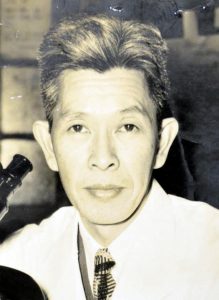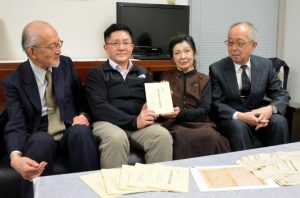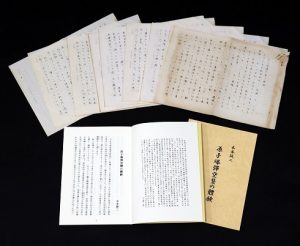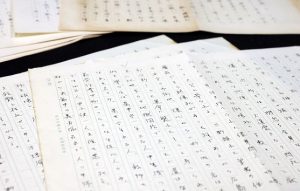Striving to fill voids in Hiroshima, evidence of victims remains—Family members publish account written by physician after A-bombing
Mar. 6, 2023
“The force from this bomb, which obliterated all living things, is truly unimaginable”
Unpublished manuscript written by Hiroshima’s Seiji Kimoto never saw light of day under occupation
by Kyosuke Mizukawa, Senior Staff Writer
An A-bomb account written less than two months after the atomic bombing by Seiji Kimoto, Hiroshima native and a medical scientist and former professor at the University of Tokyo who died in 1995 at the age of 87, was published by members of his family and another scientist. Mr. Kimoto had been contracted to write the account for a publication, but ultimately the manuscript was never published due to censorship by the General Headquarters of the Allied Powers (GHQ), led by the military of the United States, the country that dropped the atomic bomb. The document is considered valuable because it provides Mr. Kimoto’s own A-bombing experience and a summary of the devastation from the bombing observed with the typical, detached outlook of a scientist.
Mr. Kimoto was born in 1907 in Hiroshima City. After he graduated from the First Hiroshima Prefectural School (now Hiroshima Kokutaiji High School, located in the city’s Naka Ward), he entered the Faculty of Medicine at Tokyo Imperial University (now the University of Tokyo). In 1944, he became an assistant professor in the university’s surgery department. In June 1945, he temporarily returned to Hiroshima to see his father who had been injured and stayed in the city for a time as he himself fell ill. On August 6, he experienced the atomic bombing at his parents’ house in the Ushita area (now part of Hiroshima’s Higashi Ward), about three kilometers from the hypocenter.
The title of his personal written account is “Experience in the A-bombing air raid.” At a length of 17 pages, the account was transcribed by an assistant to the late Kiyoshi Kanai, an earthquake engineer, on October 15 and 16, 1945, from Mr. Kimoto’s own original handwritten manuscript, whose location at present is unknown. Mr. Kanai, a classmate of Mr. Kimoto at the First Hiroshima Prefectural School, participated in a survey of the A-bombing devastation in Hiroshima after the bombing. The account’s 17 pages were discovered amid material related to Mr. Kanai that had been donated to the Hiroshima Peace Memorial Museum (in the city’s Naka Ward) four years ago.
According to the account, Mr. Kimoto was blown off his feet by the A-bomb’s blast as he was trying to get down to an earthen floor from an elevated wooden floor after he experienced an extremely bright flash. “I was rolled over once and flung to the earthen floor. My left eardrum felt ruptured. The house collapsed with a crack, and roof tiles fell into the room.” He was injured when a nail pierced his right leg.
He wrote in the account, “In burned clothes, people had suffered hideous burns over their entire bodies, running to escape while leaning on each other’s shoulders.” In addition to the miserable condition of the wounded, he also wrote about deaths caused by radiation exposure. “So many of those who survived lost their hair after more than one month, in what were the aftereffects of exposure to the bomb’s radiation, and after four or five days were suddenly passing away.” The account continues, “The force from this bomb, which obliterated all living things, is truly unimaginable.”
Kayoshi Kudo, 79, a seismic engineer living in Tokyo who has been involved in the organization of the materials left behind by Mr. Kanai, proposed last spring, in 2022, that the written account be compiled so that many people can read it. Masako Matsuda, 84, Mr. Kimoto’s oldest daughter who lives in Sayama City in Saitama Prefecture, and his grandson, Takeshi Kimoto, 57, a resident of Tokyo, agreed to Mr. Kudo’s proposal. Hisaaki Yamanouchi, 88, Mr. Kimoto’s nephew and a scholar of English literature, did the work of helping add explanatory notes to the document.
Prior to publication of a booklet with the account, they studied the material that Ms. Matsuda had inherited and found a comment by Mr. Kimoto in an account that had been contributed to a medical journal published in 1981. “I wrote my A-bomb account for a certain magazine soon after the war, but it was suppressed by GHQ.” GHQ issued a press code on September 19, 1945, and with that reports related to the atomic bombings were also subjected to censorship.
Mr. Kimoto added that the publication at that time had requested that he write his account. The Japan Medical Journal published in October 1945, included the paper “Devastation caused by the atomic bombing of Hiroshima,” written by the late Masao Tsuzuki, who was a professor at Tokyo Imperial University at the time. Considering that the transcription of that paper was included among the material in Mr. Kanai’s possession, Mr. Kimoto’s paper could have been scheduled to appear in the same magazine. However, it is not known exactly why only Mr. Kimoto’s article was not carried in the publication.
Despite the fact that Mr. Kimoto had joined a survey of the health effects in the survivors led by Mr. Tsuzuki, under whom he studied at the Tokyo Imperial University, little was known about his account of the A-bombing. Ms. Matsuda explained, “Although it was recorded in a detached manner, I think he was shedding tears as he wrote the account. I hope his story will prove useful to young people when they consider the issue of peace.” The account in booklet form is available at the library of the Hiroshima Peace Memorial Museum, among other locations. For inquiries, please contact Mr. Kudo, at kazu-kudo@tcn-catv.ne.jp .
Valuable document written early on
Satoru Ubuki, former professor at Hiroshima Jogakuin University who specializes in research of written accounts related to the atomic bombing, said that the valuable document was written by a survivor of the atomic bombing of Hiroshima early on after the bombing based on the premise that it would be published. Having been in a position to know the results of surveys of A-bombing devastation conducted by Japanese researchers, Mr. Kimoto’s account, uniquely, included a summary of the damage even at that early point in time.
(Originally published on November 28, 2022)











